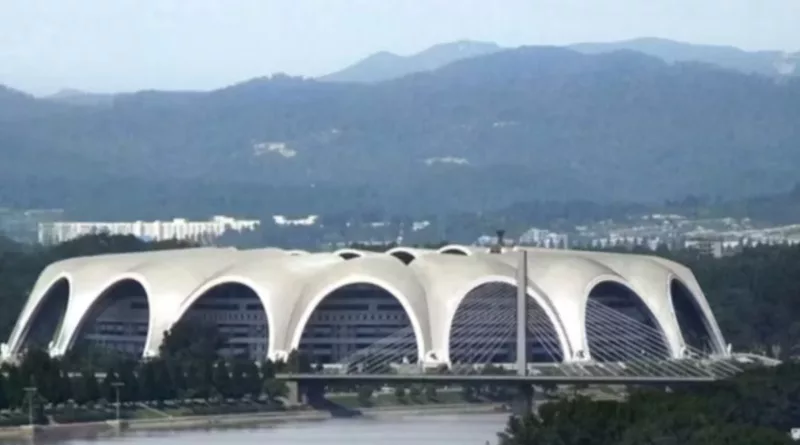Top 10 Biggest Football Stadiums in the World
Football stadiums around the world showcase a blend of architectural marvels and sheer size captivating fans with their grandeur. Among them four stadiums boast capacities exceeding 100,000 spectators with iconic venues like Wembley Stadium and Camp Nou making the cut.
Discover the 10 Largest Football Stadiums Across the Globe
From historic grounds to modern marvels, stadiums have evolved significantly over the years. Gone are the days of muddy pitches; today’s stadiums are sophisticated multi-functional structures equipped with state-of-the-art facilities.
Recent developments hint at potential renovations in the football world with Manchester United’s Old Trafford poised for a significant upgrade.
Following INEOS owner Sir Jim Ratcliffe’s minority stake in the club plans are underway to expand Old Trafford’s capacity to 90,000 seats rivalling the likes of Wembley Stadium. This move would solidify Old Trafford’s position as the largest stadium in the Premier League.
While Old Trafford’s potential expansion promises an exciting future it’s worth noting that the stadium currently falls short of making the list of the world’s largest football stadiums. However, with impending renovations, it may soon join the ranks of these colossal sporting venues.
Top 10 Biggest Football Stadiums in the World
10. Cotton Bowl Stadium: A Historic Venue Steeped in Sporting Legacy

The Cotton Bowl Stadium, with a capacity of 92,100, is an iconic symbol of sporting prowess in America. While it doesn’t have a regular host team, it is famous for hosting thrilling matchups between teams from Oklahoma and Texas during the annual State Fair.
Having been a venue for the 1994 World Cup and home to Dallas-based football clubs like Dallas Tornado and FC Dallas, its legacy is rich. A standout moment was in 2007 when it witnessed a record-breaking crowd of 96,009 during a clash between Oklahoma Sooners and Texas Longhorns. With its storied history, the Cotton Bowl Stadium remains a cornerstone of American sports.
Key Details:
- Country: USA
- Inauguration Date: October 11, 1930
- Current Capacity: 92,100
- Record Capacity: 96,009
- Clubs that Played There: FC Dallas (1996-2002/2004-2005)
9. Sanford Stadium: A Historic Hub of College Football Excellence
Sanford Stadium, situated at the University of Georgia, is a revered symbol of college football excellence with a seating capacity of 92,746. Constructed in 1929, it has been the backdrop for numerous memorable sporting events, including the football games during the 1996 Olympic Games.
Renowned for its scenic backdrop and rich history, the stadium has undergone significant renovations over the years, solidifying its status as one of America’s premier college sports arenas. Its record attendance in 2019, during a clash between Georgia Bulldogs and Notre Dame Fighting Irish, saw 93,246 spectators witness a thrilling victory. As the proud home of the Georgia Bulldogs, Sanford Stadium remains a cherished institution in college football, beloved for its grandeur and tradition.
Key Details:
- Country: USA
- Inauguration Date: October 12, 1929
- Current Capacity: 92,746
- Record Capacity: 93,246
- Clubs that Play There: Georgia Bulldogs
8. Rose Bowl Stadium: A Historic Icon of American Sports

The Rose Bowl Stadium, with its 92,800-seat capacity, holds a prominent position in American sports culture. Built in 1923, it has been a pivotal venue for various events, notably hosting eight fixtures during the 1994 World Cup, including the final.
Home to the Los Angeles Galaxy until 2003, it has also welcomed prestigious European clubs like Barcelona and Liverpool. Beyond its size, the stadium symbolizes sporting excellence and global passion.
Key Details:
- Country: USA
- Inauguration Date: July 1, 1923
- Current Capacity: 92,800
- Record Capacity: 101,799
- Clubs that Play There: LA Galaxy (1996-2003), UCLA Bruins
7. Soccer City: South Africa’s Iconic Hub of Football Glory
Soccer City, also known as the FNB Stadium in Johannesburg, South Africa, is a footballing icon with a capacity of 94,736 seats. Dubbed ‘The Calabash’ for its distinctive shape resembling an African pot, it has been the revered home ground for the South African national football team and the renowned Kaizer Chiefs since its inauguration in 1989.
Hosting historic matches, including the memorable 2010 FIFA World Cup opener where Siphiwe Tshabalala scored a stunning goal, Soccer City has become synonymous with football excellence. Beyond its impressive size, the stadium embodies pride and passion for football fans, both locally and globally.
Key Details:
- Country: South Africa
- Inauguration Date: October 7, 1989
- Current Capacity: 94,736
- Record Capacity: 88,791
- Clubs that Play There: Kaizer Chiefs, South Africa National Football Team
6. Egypt’s New Administrative Capital Stadium: A Monument of National Pride
The New Administrative Capital Stadium, unveiled in June 2023, epitomizes Egypt’s dedication to sporting excellence. With nearly 95,000 seats, it aims to become the primary venue for the Egypt national football team, replacing the Cairo International Stadium.
The stadium’s construction spanned seven years as part of Egypt’s larger initiative to develop its new administrative capital. Despite facing challenges, including delays due to the COVID-19 pandemic, the stadium opened in 2023.
Initiated in 2015, construction began in 2016 and concluded in 2022. The stadium signifies a significant step in Egypt’s sports infrastructure, providing a top-tier venue for international events and showcasing the nation’s footballing talent.
With a record capacity of 85,350 spectators, the New Administrative Capital Stadium represents Egypt’s commitment to progress and global recognition.
Key Details:
- Country: Egypt
- Inauguration Date: June 2023
- Current Capacity: 94,940
- Record Capacity: 85,350
- Clubs that Play There: Egypt National Football Team
5. Camp Nou: A Shrine of Football Excellence
Camp Nou, FC Barcelona’s iconic stadium, boasts a capacity of 99,354 spectators and a rich history of footballing brilliance since its inauguration in 1957. Currently undergoing renovations, it awaits the return of Barcelona to its hallowed grounds.
Despite temporary relocation, the stadium’s legacy lives on, with memorable moments like the record attendance of 120,000 fans during a 1986 European Cup clash. As renovations advance, Camp Nou remains a symbol of Catalan pride and footballing heritage, poised to continue its storied legacy and create new memories for fans worldwide.
Key Details:
- Country: Spain
- Inauguration Date: March 28, 1954
- Current Capacity: 99,354
- Record Capacity: 120,000
- Clubs that Play There: FC Barcelona
4. Melbourne Cricket Ground: Where Sporting Legends Converge
The Melbourne Cricket Ground (MCG), located in Melbourne, Australia, is a renowned sporting venue with a seating capacity of 100,024. Known as ‘The G’, it’s celebrated for its significance in cricket and is also the world’s biggest football stadium.
Hosting international cricket matches and memorable events like Manchester United’s 2022 pre-season campaign, the MCG has left an indelible mark on sports history. It set records with a crowd of 109,500 during Ed Sheeran’s performance in 2023 and previously saw 143,000 attendees during Billy Graham’s Crusade event.
Home to the Victoria Bushrangers in cricket and AFL teams like Melbourne Demons, Collingwood Magpies, Richmond Tigers, and Hawthorn Hawks, the MCG embodies sporting fervor and community spirit.
With its rich history and unmatched atmosphere, the Melbourne Cricket Ground remains a symbol of sporting heritage, welcoming athletes and fans to experience the magic of sport.
Key Details:
- Country: Australia
- Inauguration Date: 1853
- Current Capacity: 100,024
- Record Capacity: 143,000
- Clubs that Play There: Victoria Bushrangers (Cricket), Melbourne Demons, Collingwood Magpies, Richmond Tigers, Hawthorn Hawks
3. Ohio Stadium: A Monument to Sporting Legacy

Ohio Stadium, located in Ohio, USA, is a renowned sporting venue with a seating capacity of 102,780. Home to the Ohio State Buckeyes, it has hosted various sporting events and legendary concerts, attracting audiences worldwide.
The stadium’s rich history, including its brief stint hosting Major League Soccer games, and record attendance during college football matches, solidify its status as a premier destination for sporting and cultural spectacles.
Key Details:
- Country: USA
- Inauguration Date: October 7, 1922
- Current Capacity: 102,780
- Record Capacity: 110,045
- Clubs that Play There: Columbus Crew (1996-1999), Ohio State Buckeyes
2. Michigan Stadium: A Colossal Icon of Sporting Excellence
Michigan Stadium, known as “The Big House,” is an iconic sporting venue with a seating capacity of 107,601. Home to the Michigan Wolverines football team since 1927, it has hosted a variety of sporting events, including a memorable clash between Manchester United and Real Madrid in 2014.
The world’s biggest football stadium holds a special place in the University of Michigan community, symbolizing unity and pride.
Key Details:
- Country: USA
- Inauguration Date: October 1, 1927
- Current Capacity: 107,601
- Record Capacity: 109,318
- Clubs that Play There: Michigan Wolverines
1. Inside the Spectacular Rungrado 1st of May Stadium: A Monument of Grandeur
The Rungrado 1st of May Stadium, located in North Korea, is the largest football stadium globally, accommodating an impressive 114,000 spectators. Originally built with a capacity of 150,000, it underwent renovations in 2014 but still maintains its status as a monumental sporting venue.
Hosting various events, including football matches and the annual Pyongyang Marathon, the stadium has served as a symbol of North Korea’s sporting prowess and national pride since its inauguration on May 1, 1989.
Key Details:
- Country: North Korea
- Inauguration Date: May 1, 1989
- Current Capacity: 114,000
- Record Capacity: 190,000
- Clubs that Play There: North Korea national football team
